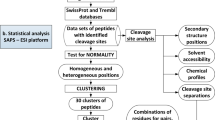Abstract
Serine proteases are a family of enzymes that degrade a wide range of proteins and play vital roles in a variety of biological processes. Their mechanism of action involves several catalytic strategies that are common in enzymatic catalysis. In this article, we review the catalytic mechanism of serine proteases and how it was elucidated over the years. The artful application of chemical probes to dissect the mechanism of serine proteases provides excellent examples for teaching present-day students and scientists how to solve complex chemical and biological problems through chemical logic.
Graphic abstract



Adapted with permission from [4]. Copyright 2002, American Chemical Society




Adapted with permission from [25]. Copyright 1976, American Chemical Society
Similar content being viewed by others
References
Balter M (1996) New hope in HIV disease. Science 274:1988–1989
Neitzel JJ (2010) Enzyme catalysis: the serine proteases. Nat Educ 3(9):21. https://www.nature.com/scitable/topicpage/enzyme-catalysis-the-serine-proteases-nbsp-14398894/. Accessed 2 Oct 2019
Pietzsch J (2019) Signalling scissors: new perspectives on proteases. https://www.nature.com/horizon/proteases/background/prespective.html. Accessed 2 Oct 2019
Hedstrom L (2002) Serine protease mechanism and specificity. Chem Rev 102(12):4501–4523
Oda K (2012) New families of carboxyl peptidases: serine-carboxyl peptidases and glutamic peptidases. J Biochem 151(1):13–25
MEROPS—the Peptidase Database (2019) EMBL-European Bioinformatics Institute, Cambridge. https://www.ebi.ac.uk/merops/
Brix K, Stöcker W (eds) (2013) Proteases: structure and function. Springer, Vienna (ISBN: 9783709108840)
Schechter I, Berger A (1967) On the size of the active site in proteases. I. Papain. Biochem Biophys Res Commun 27:157–162
Almeida P (2016) Proteins: concepts in biochemistry. CRC Press, Boca Raton (ISBN: 9780815345022)
Corey DR, Craik CS (1992) An investigation into the minimum requirements for peptide hydrolysis by mutation of the catalytic triad of trypsin. J Am Chem Soc 114:1784–1790
Pauling L (1967) Peace on earth: the position of the scientists. Bull At Sci 23(8):46–48
Hartley BS, Kirby BA (1954) The reaction of p-nitrophenyl esters with chymotrypsin and insulin. Biochem J 56(2):288–297
Westheimer FH (1995) Biographical memoirs: Vol. 66. Chapter: Myron Lee Bender. The National Academies Press, Washington. https://www.nap.edu/read/4961/chapter/3#20. Accessed 2 Oct 2019
McDonald LE, Balls AK (1957) Analogues of acetyl chymotrypsin. J Biol Chem 227:727–736
Silverman RB (2002) Organic chemistry of enzyme-catalyzed reactions, revised edition, 2nd edn. Academic, New York (ISBN: 9780080513362)
Powers JC, Asgian JL, Ekici OD, James KE (2002) Irreversible inhibitors of serine, cysteine, and threonine proteases. Chem Rev 102(12):4639–4750
Bernhard SA, Tashjian ZH (1965) Acyl intermediates in the α-chymotrypsin-catalyzed hydrolysis of indoleacryloylimidazole. J Am Chem Soc 87(8):1806–1807
Henderson R (1970) Structure of crystalline α-chymotrypsin: IV. The structure of indoleacryloyl-α-chymotrypsin and its relevance to the hydrolytic mechanism of the enzyme. J Mol Biol 54(2):341–354
Dixon MM, Brennan RG, Matthews BW (1991) Structure of γ-chymotrypsin in the range pH 2.0 to pH 10.5 suggests that γ-chymotrypsin is a covalent acyl-enzyme adduct at low pH. Int J Biol Macromol 13(2):89–96
Ashton DS, Beddell CR, Cooper DJ, Green BN, Oliver RW, Welham KJ (1991) Some electrospray mass spectrometric evidence for the existence of covalent O-acyl enzyme intermediates. FEBS Lett 292(1–2):201–204
Zerner B, Bond RPM, Bender ML (1964) Kinetic evidence for the formation of acyl-enzyme intermediates in the α-chymotrypsin-catalyzed hydrolyses of specific substrates. J Am Chem Soc 86(18):3674–3679
Kraut J (1977) Serine proteases: structure and mechanism of catalysis. Ann Rev Biochem 46:331–358
Fastrez J, Fersht AR (1973) Demonstration of the acyl-enzyme mechanism for the hydrolysis of peptides and anilides by chymotrypsin. Biochemistry 12(11):2025–2034
Bauer CA, Lofqvist B, Petterss G (1974) Studies on the catalytic mechanism of a serine protease from Streptomyces griseus. Eur J Biochem 41:45–49
Hunkapiller MW, Forgac MD, Richards JH (1976) Mechanism of action of serine proteases: tetrahedral intermediate and concerted proton transfer. Biochemistry 15(25):5581–5588
Copeland RA (2000) Enzymes: a practical introduction to structure, mechanism, and data analysis, 2nd edn. Wiley, New York (ISBN: 978-0-471-35929-6)
Perona JJ, Craik CS (1995) Structural basis of substrate specificity in the serine proteases. Protein Sci 4:337–360
Acknowledgements
V. Blay thanks the Ohio State University, Fisher College of Business for support. The article is based on selected content from the course “Enzymes” (BIOCHEM 6762, Ohio State University), created by Prof. Dehua Pei and Prof. Ming-Daw Tsai.
Author information
Authors and Affiliations
Corresponding author
Additional information
Publisher's Note
Springer Nature remains neutral with regard to jurisdictional claims in published maps and institutional affiliations.
Rights and permissions
About this article
Cite this article
Blay, V., Pei, D. Serine proteases: how did chemists tease out their catalytic mechanism?. ChemTexts 5, 19 (2019). https://doi.org/10.1007/s40828-019-0093-4
Received:
Accepted:
Published:
DOI: https://doi.org/10.1007/s40828-019-0093-4




